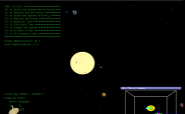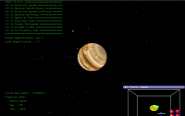illiSol: A Modern Orrery
The illiSol Project initially began in Spring 2008 as my final project for Dr. Francis' Math 198 course, which covered topics of mathematical visualization. illiSol was an effort to create a visualization of the Sol star system, with accurate scale orbits. All of this was possible with a system of equations provided by Jet Propulsion Labs, and was built using OpenGL in Syzygy. A standalone executable and the source code are available in the downloads section, though no compilation has as of yet been made on any UNIX machine.
The application features a number of beautifying elements. For one, Stuart Levy's OpenGL Stars form the background, though as of this writing, they are neither oriented correctly nor do they move correctly based on user input. The planets are also textured with raw image files, and are mapped so that higher resolution images are used when the planets are viewed from a closer distance - this is a feature of OpenGL, and though not entirely efficient, serves our purposes well. Some satellites (moons) are included with some of the planets, but these are neither texture mapped nor do they follow correct orbits.
The issue of scale has always been a question to seriously ponder, as the Integrated Systems Laboratory discovered in porting the popular FOSS Celestia into the virtual environments. illiSol deals with this by allowing the user to adjust scale, both time and spatial, according to their whim. In the case of time, users can speed up and slow down, or even freeze time (which begins from the launch date of the Voyager II mission). For the desktop application, there is also the option for the user to go back one Earth-year in time.
More problematic is the issue of spatial scale, as the Sun is so drastically huge in comparison to everything else in the solar system. illiSol attempts to tackle this problem by allowing non-uniform scaling techniques, where the user can scale the planets and the sun by different proportions, but still has the option to return to "true scale". Indeed, after playing around with the application for a short time, one can see that this is still an imperfect method, as not all distances are scaled in the same way - ultimately, individual planetary systems begin to run into each other.
There are still improvements to be made to illiSol, to make
it a truely useful visualization. A recent modification has
made virtual environment traversal of the orrery much more user
friendly, although the build on this website still has a more
desktop-friendly navigation system included. That said, here are
some of the area that should see improvement this summer:
- Orient Stuart Levy's OpenGL Stars correctly
- Integrate said Stars so that they move correctly based on user input
- An improved navigation system for the desktop
- Add a local light source to Sol (the Sun) so that correct shading applies to the planets and their elements
- Add planetary rotation to the application - this shouldn't be too hard
- Put the moons in their correct orbits - this may or may not come to fruition, depending on time constraints
Update July 7, 2008: Two of the above have been
implemented, although the application has not been tested
recently in the cluster setting.
- The stars now move correctly based on user input
- Lighting as been added to the application, so that the planets actually appear spherical.
Update July 10, 2008: I have begun writing a paper detailing the history and mathematics behind illiSol. I will post a current copy of it each day I work on it.
- July 10, 2008 - Set up the LaTeX file and
began writing. Completed the Introduction and
Overview sections.
- July 17, 2008 - Worked on a large portion of
the History section, which is actually turning
out to be more if a historical mathematics
section. Included are some pictures that I've
made in Inkscape (.svg files). Unfortunately,
there's no easy way to get .svg files in LaTeX,
so I've shrunk them using GIMP and saved them
as PNG images.
- July 18, 2008 - Finished subsection proving
direction of planetary acceleration in the
Historical Mathematics section, and
reworded part of the same section to be
clearer.
- July 21, 2008 - Finished writing the
Historical Mathematics section and
started in on the Modern Methods for
Computing Orbits section. I've also
had to redevelop a few of my images as my
understanding of one of the Keplerian Elements
was incorrect.
- July 25, 2008 -In the Modern Methods
section, I have begun a moderately in depth
explanation of the Keplerian Elements of an
elliptical orbit. I plan to tie this in with
the JPL equations, write a bibliography, and
proof it sometime this weekend.
- July 26, 2008 -The first draft of the body
of the paper is finished, including a
Summary, Conclusion, and Acknowledgements
section. The only writing portion left to be
done is the bibliography, and some proof
reading is necessary as well.
- July 29, 2008 -Final Paper! Any suggestions
are welcome, and will be added if appropriate
(although the changes may not make it onto this
website).
Final Paper PDF
Update July 14, 2008: Today I created an image to aid in visualizing the Keplerian Elements that JPL uses in their documentation. To understand the elements they use (Inclination, Mean Longitude, Longitude of Perihelion, and Longitude of Ascending Node), take a look at this picture.
- Removed!
Update July 21, 2008: Today I recreated the image aiding visualization of the Keplerian Elements that is linked above from the 14th.


